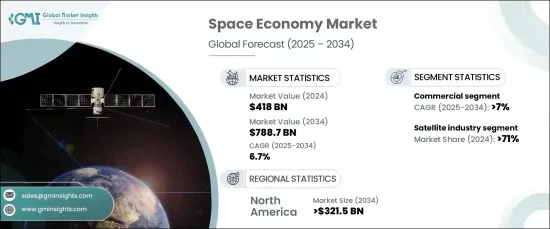PUBLISHER: Global Market Insights Inc. | PRODUCT CODE: 1665290

PUBLISHER: Global Market Insights Inc. | PRODUCT CODE: 1665290
Space Economy Market Opportunity, Growth Drivers, Industry Trend Analysis, and Forecast 2025 - 2034
The Global Space Economy Market was valued at USD 418 billion in 2024 and is projected to experience robust growth, expanding at a CAGR of 6.7% from 2025 to 2034. This growth is driven by the increasing adoption of space technologies across various industries, which is revolutionizing operations and opening up new revenue opportunities.

Technological innovations in satellites and rockets are making space more accessible and cost-effective, fueling market expansion. These advancements are benefiting industries such as transportation, logistics, and disaster management by providing capabilities like real-time tracking, global communication, and advanced weather monitoring. As businesses continue to integrate space-based solutions, the market is poised to unlock even more potential for growth and operational efficiency.
| Market Scope | |
|---|---|
| Start Year | 2024 |
| Forecast Year | 2025-2034 |
| Start Value | $418 billion |
| Forecast Value | $788.7 billion |
| CAGR | 6.7% |
The space economy market is primarily divided into three key segments: the satellite industry, the non-satellite industry, and space sustainability activities. The satellite industry dominated the market in 2024, accounting for a significant 71% share. This dominance is expected to continue as demand for satellite services in telecommunications, navigation, and Earth observation continues to rise. Companies are increasingly focusing on deploying small satellites in Low Earth Orbit (LEO), which are crucial for enhancing global internet connectivity, gathering data, and supporting seamless communication. Satellite technology also plays a vital role in various sectors, including agriculture, logistics, and disaster response, empowering organizations to make data-driven decisions that enhance operational effectiveness.
When it comes to end users, the space economy market is divided into the commercial sector and the government and defense sector. The commercial segment is projected to grow at a CAGR of 7% through 2034. This surge is driven by a growing demand for satellite-based services, particularly for global broadband and IoT connectivity. Expanding LEO satellite constellations are improving network coverage and response times, enabling more reliable communication and advanced remote sensing capabilities. These technological breakthroughs are especially beneficial for regions lacking traditional infrastructure, accelerating the adoption of satellite services across industries.
North America is expected to generate USD 321.5 billion in space economy market revenue by 2034. The U.S. is at the forefront of this growth, bolstered by substantial government funding and private-sector involvement. Key developments in satellite deployment and reduced launch costs are accelerating the expansion of the market. The U.S. continues to lead the way in building satellite networks for global broadband services, driving improved connectivity in underserved regions, and fostering innovation in the tech sector.
Table of Contents
Chapter 1 Methodology & Scope
- 1.1 Market scope & definitions
- 1.2 Base estimates & calculations
- 1.3 Forecast calculations
- 1.4 Data sources
- 1.4.1 Primary
- 1.4.2 Secondary
- 1.4.2.1 Paid sources
- 1.4.2.2 Public sources
Chapter 2 Executive Summary
- 2.1 Industry synopsis, 2021-2034
Chapter 3 Industry Insights
- 3.1 Industry ecosystem analysis
- 3.1.1 Factor affecting the value chain
- 3.1.2 Profit margin analysis
- 3.1.3 Disruptions
- 3.1.4 Future outlook
- 3.1.5 Manufacturers
- 3.1.6 Distributors
- 3.2 Supplier landscape
- 3.3 Profit margin analysis
- 3.4 Key news & initiatives
- 3.5 Regulatory landscape
- 3.6 Impact forces
- 3.6.1 Growth drivers
- 3.6.1.1 Technological advancements in space technologies
- 3.6.1.2 Surge in satellite applications for communication, Earth observation, and global positioning
- 3.6.1.3 Growing commercialization of space
- 3.6.1.4 Rising international collaboration and investments
- 3.6.1.5 Increasing government funding for space exploration
- 3.6.2 Industry pitfalls & challenges
- 3.6.2.1 High costs and investment risks
- 3.6.2.2 Environmental and sustainability issues
- 3.6.1 Growth drivers
- 3.7 Growth potential analysis
- 3.8 Porter’s analysis
- 3.9 PESTEL analysis
Chapter 4 Competitive Landscape, 2024
- 4.1 Introduction
- 4.2 Company market share analysis
- 4.3 Competitive positioning matrix
- 4.4 Strategic outlook matrix
Chapter 5 Market Estimates & Forecast, By Type, 2021-2034 (USD Million)
- 5.1 Key trends
- 5.2 Satellite industry
- 5.2.1 Satellite launch
- 5.2.2 Satellite services
- 5.2.3 Satellite manufacturing
- 5.2.4 Satellite ground equipment
- 5.3 Non-Satellite Industry
- 5.3.1 Government space budgets
- 5.3.2 Commercial human spaceflight
- 5.4 Space sustainability activities
Chapter 6 Market Estimates & Forecast, By End Use, 2021-2034 (USD Million)
- 6.1 Key trends
- 6.2 Commercial
- 6.3 Government & defense
Chapter 7 Market Estimates & Forecast, By Region, 2021-2034 (USD Million)
- 7.1 Key trends
- 7.2 North America
- 7.2.1 U.S.
- 7.2.2 Canada
- 7.3 Europe
- 7.3.1 UK
- 7.3.2 Germany
- 7.3.3 France
- 7.3.4 Italy
- 7.3.5 Spain
- 7.3.6 Russia
- 7.4 Asia Pacific
- 7.4.1 China
- 7.4.2 India
- 7.4.3 Japan
- 7.4.4 South Korea
- 7.4.5 Australia
- 7.5 Latin America
- 7.5.1 Brazil
- 7.5.2 Mexico
- 7.6 MEA
- 7.6.1 South Africa
- 7.6.2 Saudi Arabia
- 7.6.3 UAE
Chapter 8 Company Profiles
- 8.1 AeroVironment
- 8.2 Airbus
- 8.3 BAE Systems
- 8.4 Blue Origin
- 8.5 Boeing
- 8.6 Elbit Systems
- 8.7 General Dynamics
- 8.8 Indian Space Research Organisation
- 8.9 Israel Aerospace Industries
- 8.10 Lockheed Martin
- 8.11 Maxar Technologies
- 8.12 Northrop Grumman
- 8.13 Raytheon Technologies
- 8.14 SpaceX
- 8.15 Thales
- 8.16 Viasat




